Francis Alÿs, Sometimes Making Something Leads to Nothing, 1997
Paradox of Praxis 1.
“Paradox of Praxis 1 (1997) is the record of an action carried out under the rubric of “sometimes making something leads to nothing.” For more than nine hours, Alÿs pushed a block of ice through the streets of Mexico City until it completely melted. And so for hour after hour he struggled with the quintessentially Minimal rectangular block until finally it was reduced to no more than an ice cube suitable for a whisky on the rocks, so small that he could casually kick it along the street.”
text and video: https://francisalys.com/sometimes-making-something-leads-to-nothing/
Francis Alÿs, The Green Line, 2004

In collaboration with Philippe Bellaiche, Rachel Leah Jones, and Julien Devaux.
“Sometimes doing something poetic can become political and sometimes doing something political can become poetic.”
“In the summer of 1995 I performed a walk with a leaking can of blue paint in the city of São Paulo.The walk was then read as a poetic gesture of sorts. In June 2004, I re-enacted that same performance with a leaking can of green paint by tracing a line following the portion of the ‘Green Line’ that runs through the municipality of Jerusalem. 58 liters of green paint were used to trace 24 km. Shortly after, a filmed documentation of the walk was presented to a number of people whom I invited to react spontaneously to the action and the circumstances within which it was performed.”
Text and video: https://francisalys.com/the-green-line/
Francis Alÿs, Cuentos patrióticos, 1997
In collaboration with Rafael Ortega.
Video: https://francisalys.com/cuentos-patrioticos/
Francis Alÿs, Tornado, 2010
Mexico, 2010, 00:42min
Eryn Foster, New Canadian Pilgramages, 2007 –

The first NCP walk (275km) took place in 2007 as part of OK Quoi! Performance Art Festival in Sackville New Brunswick.
New Canadian Pilgrimages: 2 (2008) was a 500 km walk around the perimeter and interior of Prince Edward Island. It included a gallery-based performative installation titled: “Virtual Pilgrimage Machine” that was installed at Struts Artist Run Centre in Sackville, New Brunswick. Visitors to the gallery could join me, virtually, while walking on the treadmill and talking to be on the telephone.
The third New Canadian Pilgrimages project was an 8 day walk that took place in 2010. Titled: Each of Your Five Fingers Represents 15 Minutes of Time, it took place from Sackville, NB to Fundy National Park via the Dobson Trail. (apx. 150 km)
The next New Canadian Pilgrimages will take place this summer, 2014 on Pictou Island in Nova Scotia. NCP:4 Pictou Island Portage, will be structured as a moving/walking artist residency that will also involve six additional artists from across Canada: Michael Waterman, Aimee Brown, Ursula Johnson, Sheilah Wilson, Doug Smarch, and Barbara Lounder.”
Image and text: http://erynfoster.ca/Works/New-Canadian-Pilgrimages-2007-ongoing

Eryn Foster, walking and talking and not saying anything, 2013
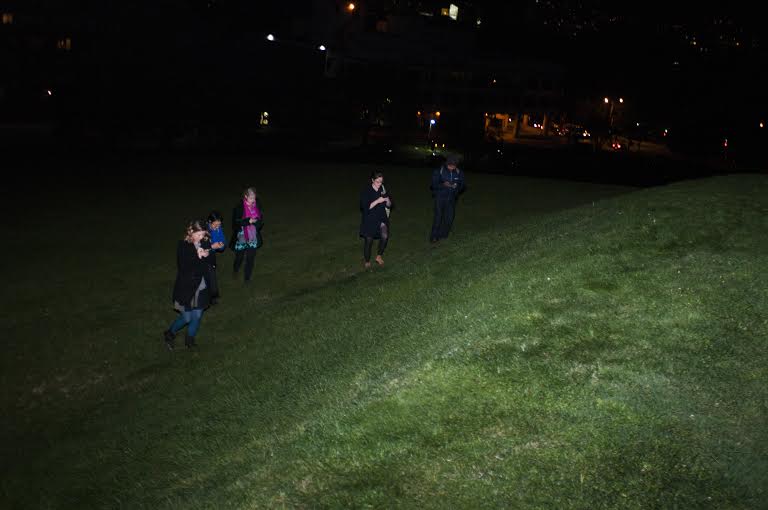
walking and talking and not saying anything was presented as part of “Tracing the City, Interventions in Public Space”, a conference organized by Dalhousie Art Gallery and NSCAD University.”
See: http://tracingthecity.ca/colloquium/program
for more information
D’Arcy Wilson also writes about walking and talking and not saying anything in C Magazine Issue 121 “Walking”
https://cmagazine.com/2014_121.htm
Text and Image: http://erynfoster.ca/Works/walking-and-talking-and-not-saying-anything-2013
Walking Lab, performing lines & research-creation, ongoing

WalkingLab, which is a component of the larger funded research project, archives the networked activities generated through the grant, hosts a series of online residencies and blogs on the theme of walking, commissions a series of artists’ projects that interrogate what it means to move, and acts as a hub that connects researchers, educators, and the public through additional resources and pedagogical tools.
image and text: https://walkinglab.org/about/
Walking Lab and RiVAL; The bank, the mine, the colony, the crime: A walk for the radical imagination against Bay Street, 2018

This glass, metal and concrete zone is a reactor of the imagination, where the abstract codes of global finance fuse with the settler colonial logics of racialized extraction and neoliberal capitalism. But what else might the imagination generate if we assembled ourselves otherwise? What resilient pasts, rebellious presents and radical futures flow beneath the surface, ready to erupt? How can we imagine and enact the complex solidarities we need to overturn the financialized global order of deadly inequalities and the fascistic spectres it unleashes?
WalkingLab and the ReImagining Value Action Lab (RiVAL) propose to assemble a temporary community of activists, artists, scholars and other peripatetic counter-speculators to investigate and challenge this power by walking together. On 5 October 2019 we will assemble in Toronto’s financial district to share our knowledge, ideas and forms of resistance through a series of presentations at various locations. We are calling for expressions of interest from those who might be willing to share their stories and talents as part of a collaborative walking tour.
ORGANIZING:
Writing of their project WalkingLab, Sarah E. Truman and Stephanie Springgay write: Conventional walking tours can reinforce dominant histories, memories, power relations, and normative or fixed understandings of place. This place-based knowledge serves various forms of governance, ideology, and maintains the status quo including the ongoing violence of settler colonization, and the erasure of racialized, gendered, and differently abled bodies. To counter dominant and normative walking tours that “take place” in specific locations, we developed a method we call a ‘queer walking tour’ to advocate for a critical consideration of place. This criticality, following Tuck and McKenzie, not only recognizes place as socially, culturally, politically, geosocially, and relationally constructed, it also considers “the place-based processes of colonization and settler colonization and works against their further erasure or neutralization through social science research.” The implication of queer walking tours is that they offer a form of place-based research that seeks to attend more responsibly and ethically to issues of place.
RiVAL: the ReImagining Value Action Lab is a workshop for the radical imagination, social justice and decolonization located in Anishinaabe Aki (Thunder Bay, Canada) and active around the world. It is co-directed by activist-artists Cassie Thornton and Canada Research Chair in Culture, Media and Social Justice Max Haiven. RiVAL seeks to convoke the radical imagination using methods that include hosting conferences, symposia and summer camps, hosting workshops, film screenings and talks, supporting research, pedagogy and debate on key themes, publishing in print and online and organizing walking tours and other experimental public events. This event follows on a successful walking tour of London’s financial district organized by RiVAL’s Max Haiven and Aris Komporozos-Athanasiou of University College London in Spring of 2018.
Image and text: http://rival.lakeheadu.ca/torontotour/
Tim Knowles, Nightwalk – Valley of Rocks #1, 2008

1220 x 1520mm
C-type print mounted on Aluminium and framed with non-reflective glass.
Edition of 6 + 2 AP
“Nightwalks are a series of illuminated walks that Tim Knowles created in the countryside during a new moon. Over the period of an hour, the artist walked away from the camera while carrying three wide-beam torches. His path, along a precarious rocky ridge in the darkness, was illuminated and captured using a long-exposure, large-format photograph. The image invokes Plato’s allegory of the cave, appearing like a pathway of ghostly travellers shining inside an electrified landscape.”
Text and image: http://timknowles.co.uk/Work/Nightwalks/ValleyofRocks/tabid/508/Default.aspx
Tim Knowles, Windwalk – Seven walks from Seven Dials, 2009


2009
“Detail of drawing [above] showing how as the meandering route of the windwalker [guided solely by the wind] collides with buildings, walls, railings, ventilation shafts, parked vehicles…. glimpses of the city’s structure are revealed.”
Text and images: http://timknowles.co.uk/Work/Windwalks/SevenDials/tabid/503/Default.aspx
Mammalian Diving Reflex, Nightwalks with Teenagers, On-going

Text, image and video: https://mammalian.ca/projects/nightwalks-with-teenagers/
Carmen Papalia, Blind Field Shuttle walking tour, 2012

The core component of Papalia’s exhibition will be a multichannel sound installation documenting a non-visual site mapping workshop that Papalia conducted in Vancouver, British Columbia, and a number of images and videos documenting various instances of Papalia’s Blind Field Shuttle walking tour and his See for Yourself non-visual museum tour project—in which visitors close their eyes and embark on a one-on-one tour while art objects, architectural details and other museum visitors are described to them by a tour guide.”
Image and text: http://cueartfoundation.org/carmen-papalia
CARMEN PAPALIA, MOBILITY DEVICE, 2016
Richard Long, A line made by Walking, 1967
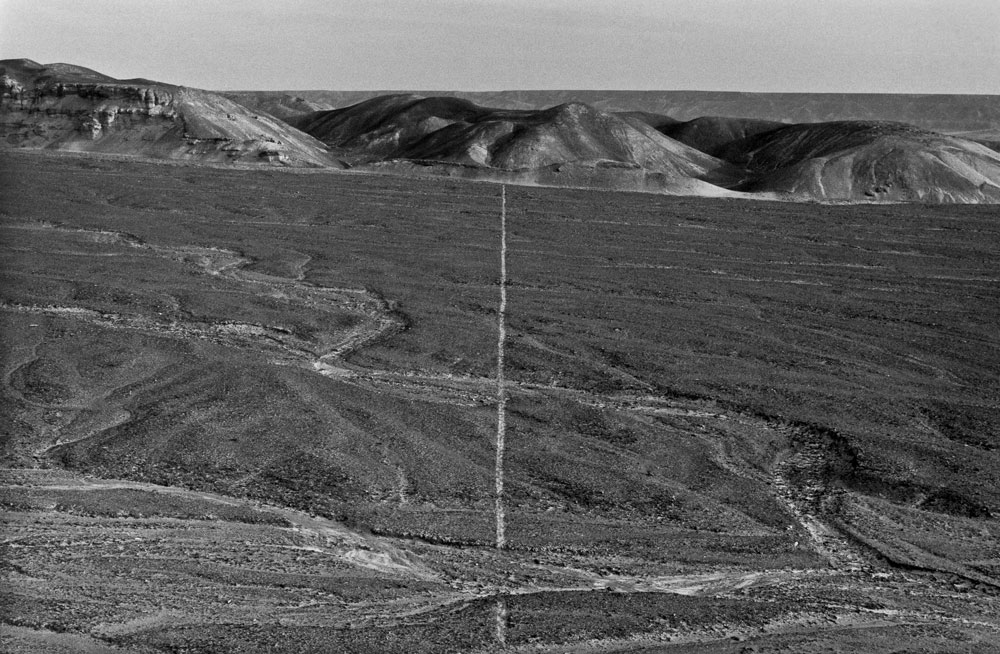
In his work, often cited as a response to the environments he walked in, the landscape would be deliberately changed in some way, as in A Line Made by Walking (1967), and sometimes sculptures were made in the landscape from rocks or similar found materials and then photographed. Other pieces consist of photographs or maps of unaltered landscapes accompanied by texts detailing the location and time of the walk it indicates.”
Text: https://en.wikipedia.org/wiki/Richard_Long_%28artist%29
Image: http://www.richardlong.org/
Richard Long, WALKING A LINE IN PERU, 1972
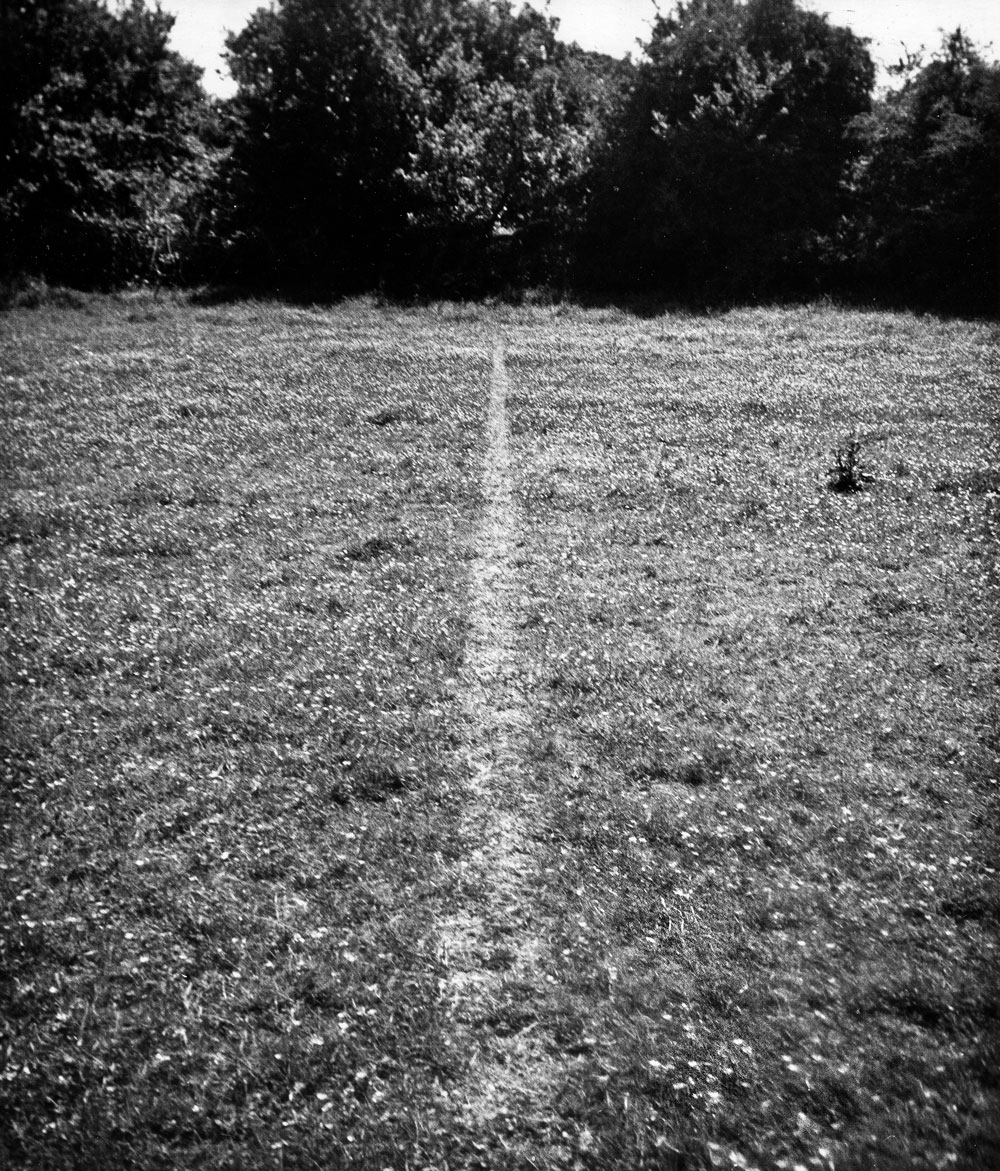
Janine Antoni and Paul Ramirez Jonas, Migration, 1999

Having traveled far from their home countries, the artists depict their movements as a series of steps where, at different times, one partner leads and the other follows. The actions within Migration speak to the dynamic and continuous negotiations that happen within a relationship.”
Text: http://www.janineantoni.net/migration
Image: https://glasstire.com/2012/11/23/the-ten-list-walk-as-art/
Hamish Fulton, Walking on the Iberian Peninsula, 2018

Fulton states “A walk has a life of its own and does not need to be materialized into a work of art. An artwork cannot re-present the experience of a walk…I attempt to ‘leave no trace.’”
Text: https://glasstire.com/2012/11/23/the-ten-list-walk-as-art/
“Hamish Fulton (born 1946) is an English walking artist. Since 1972 he has only made works based on the experience of walks.[1] He translates his walks into a variety of media, including photography, illustrations, and wall texts. His work is contained in major museums collections, such as the Tate Britain and MoMA.[2] Since 1994 he has begun practicing group walks.[3] Fulton argues that ‘walking is an artform in its own right’ and argues for wider acknowledgement of walking art.[4]“
Text: https://www.moma.org/artists/2033
Image: https://www.bombasgens.com/en/activities/processes-walking-with-hamish-fulton/
Artist website: http://www.hamish-fulton.com/
Tehching Hsieh, One Year Performance, (1981)
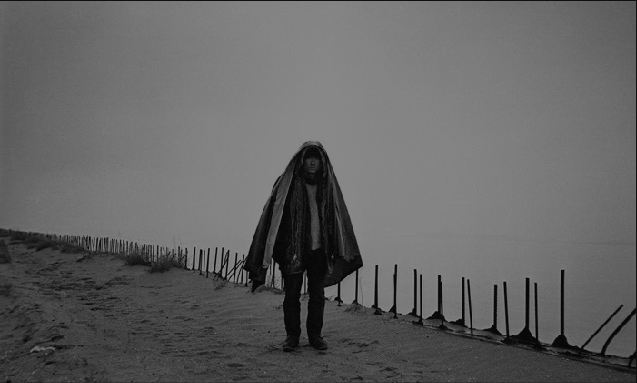
Images and text: https://glasstire.com/2012/11/23/the-ten-list-walk-as-art/
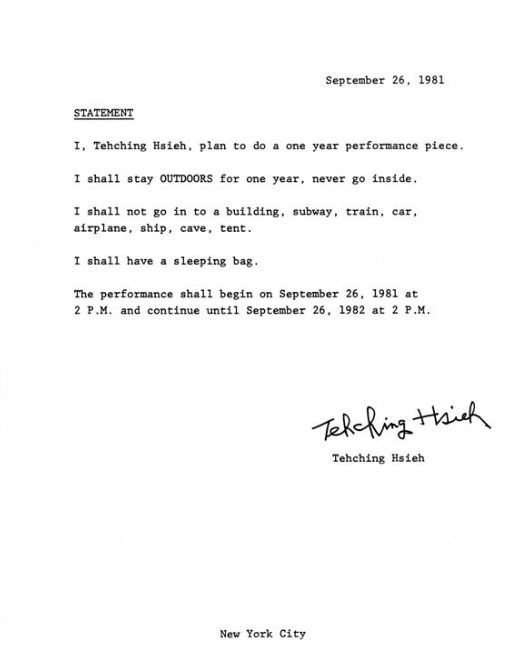
Narratives in Space + Time Society, Walking the Debris Field: Public Geographies of the Halifax Explosion, 2017

One morning in the summer, Lounder, Bean and I take a walk near the epicentre of the disaster, now blocked from view by the Irving Shipyard. We meet at the Nova Scotia Supreme Court (Family Division) on Devonshire Avenue, built immediately following the Explosion to house the Richmond School. The first Richmond School, nearby on Roome Street, had been destroyed in the blast. On that morning in 1917, two children died inside the Roome Street School, and 87 of their classmates died on the way; many were drawn to the waterfront to see the Mont-Blanc on fire at Pier 6. Nine-year-old Annie Perry Campbell, who lived on Kenny Street, was one of those children. Photographs of her are on display in the lobby of the courthouse.
From the courthouse, we walk through the former community of Richmond (it’s been reduced to a street name) to view the “house holes” at the corner of Albert and Roome Streets, depressions in the grass where houses once stood. We then pass through Mulgrave Park, which overlooks the Irving Halifax Shipyard. From there, it’s on to Fort Needham Memorial Park, where the official memorial is, and back to the courthouse.
Mulgrave Park reveals a startling panorama of the Narrows where the Imo struck the Mont-Blanc, Pier 6 where the explosion occurred and the contemporary urban geography of Halifax that has been defined by this military disaster.
Both now and then, this area is a diverse part of Halifax, a working-class residential neighbourhood, with industry and military installations along the waterfront. In 1917 it was where the Acadia Sugar Refinery, the Richmond Printing Company, Hillis & Sons Foundry and Dominion Textiles cotton mill were located. Entire neighbourhoods were flattened, including the community of Africville further along the shores of Halifax Harbour. Dartmouth, across the harbour, also suffered; Oland’s brewery was in ruins, and the Mi’kmaq community at Turtle Grove was obliterated. Today, the Irving Shipyard dominates the neighbourhood of the Halifax explosion.
The stories of the dead and traumatized are never far from Lounder’s mind, as she returns again and again to the area. She did the first walk by herself in 2009, retracing Arthur Lismer’s journey that morning. On Dec. 6, 1917, Lismer, then principal of the Victoria School of Art and Design (now NSCAD University) was at home in Bedford, taking the morning off because he always worked Saturdays teaching children. The blast shook the wooden house on Cliff Street, shattering windows, and Lismer set off on foot for Halifax, walking along the train tracks. Along the way to the school (located at the present-day Five Fishermen Restaurant), he made sketches of the devastation. These were some of the first images capturing the explosion aftermath and published in international newspapers. The walk that Lounder made on December 6 also commemorated the Montreal massacre, an event that shares the date of the Halifax explosion.”
Image and text: https://nscad.ca/post-title-6/
Website:http://www.narrativesinspaceandtime.ca/


Vito Acconci, Following Piece (1969)

image: https://glasstire.com/2012/11/23/the-ten-list-walk-as-art/
text: https://www.metmuseum.org/art/collection/search/190036953

Janet Cardiff and George Bures Miller, The Alter Bahnhof Video Walk, 2012
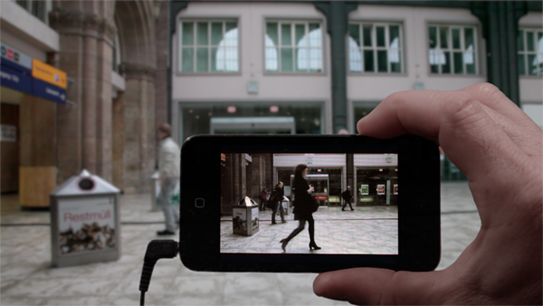
Image and text: http://www.cardiffmiller.com/artworks/walks/index.html
Guy Debord, The Naked City (1957)
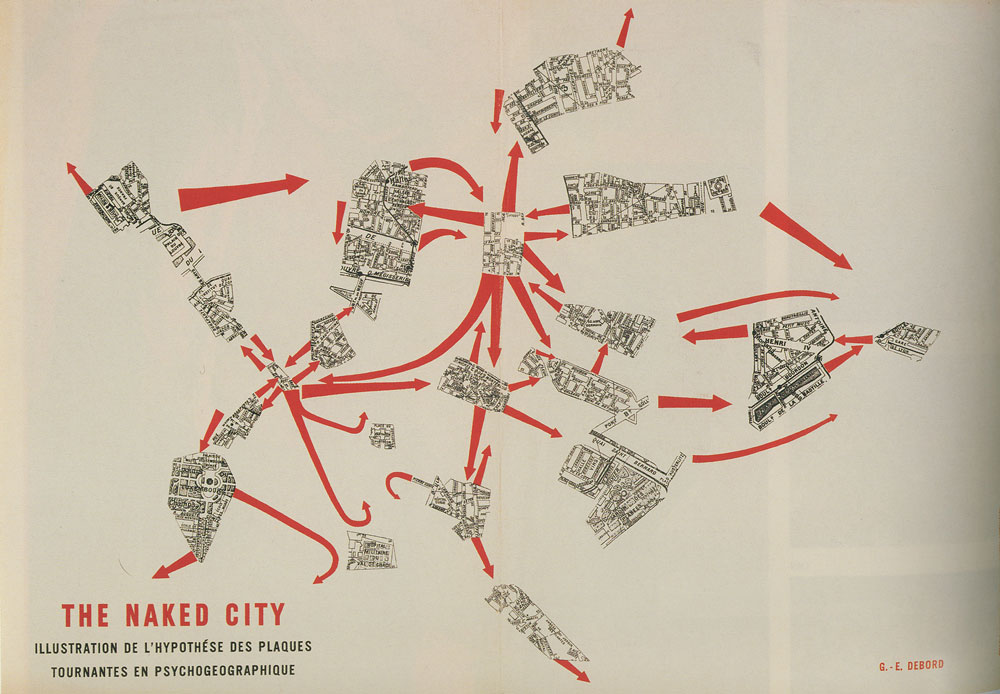
“We are bored in the city, we really have to strain to still discover mysteries on the sidewalk.” – Ivan Chtcheglov, 1953
In addition to inspiring artists, architects and urban planners, the Situationist International’s take-back of public space is credited as catalyzing the The Occupy movement.
“We are not just inspired by what happened in the Arab Spring recently, we are students of the Situationist movement…One of the key guys was Guy Debord, who wrote The Society of the Spectacle. The idea is that if you have a very powerful meme … and the moment is ripe, then that is enough to ignite a revolution. This is the background that we come out of.” – Kalle Lasn, editor and co-founder of Adbusters, the group and magazine credited for Occupy Wall Street’s initial concept and publicity.”
Image and Text:https://glasstire.com/2012/11/23/the-ten-list-walk-as-art/
Gudrun Filipska and Carly Butler, The S Project, On-going
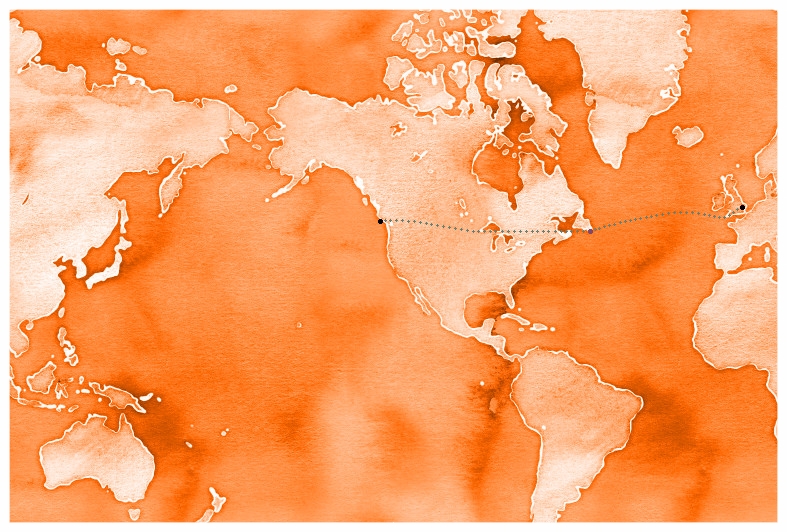
The project makes reference to parenthood and the pull of domestic domains and how they affect and change walking practices, and feeds into wider research into the ethical implications of the Fugal walk set against the grand narratives of journeying and pioneering. ‘S’ was germinated out of a shared ambivilance about the identities generated around ‘Motherhood’, identities which both artists simultaneously push against and work within the boundaries of – often in the sense of exploring time, space, navigation and travel. This walking project is a physical expression of these limitations, both aspirational in its distance and magnitude and yet humble in its inception – walking without leaving home.
Filipska and Butler are also mapping a number of different routes to find the ‘true’ half way point between their respective homes using combinations of celestial, nautical and gnomonic mapping techniques, these maps form part of the ‘S’ archive along with a catalogue of objects, artefacts and letters sent between them; a postal exchange which has included Butler sending Filipska seawater vial by vial until she has enough to fill a fishtank.
Text and Image: http://www.gudrunfilipska.com/butler-filipska
Artist Websites:
http://carlybutler.com/project/s-from-fordham-to-ucluelet/
http://www.gudrunfilipska.com/butler-filipska
GIS MAP: https://www.arcgis.com/apps/MapSeries/index.html?appid=bc26ddce8dd54fcc8ba4e0678f05aeb9
Tino Seghal, This Progress, 2010

“A few Saturdays ago, a teenage visitor to the Guggenheim Museum, a girl in a black beret, slid open the door to the Aye Simon Reading Room and peered in at a group of people in animated conversation. “Is there something going on in here?” she said.
A woman wearing red lipstick and Converse sneakers glared at her for a moment and turned away. “It’s a staff room,” a tall man in a plaid shirt said brusquely.
The girl in the beret backed up and slid the door closed. If she had been looking for art — there was none to be seen on the walls of the rotunda at the time — she had found it. But it was rather emphatically taking a break.
The men and women in the room were part of “This Progress,” a work by the British-German artist Tino Sehgal that took over the rotunda for the last six weeks. In the piece, which closed Wednesday, visitors were ushered up the spiral ramp by a series of guides — first a child, then a teenager, then an adult and finally an older person — who asked them questions related to the idea of progress.
Over the course of several hours-long shifts a week for the six-week run of the show, each of these guides, or “interpreters” as Mr. Sehgal calls them, spent a few minutes walking and talking with one or more visitors at a time, then moved on to the next. The show was extremely popular, with final ticket sales of more than 100,000, and on busy weekends a guide might interact with as many as 70 people in a day. By the time the guides retired to one of the break rooms — the reading room had been set aside for the teenagers and adults — they were taking refuge from encounters with the public.
Still, they were clearly invested in the spirit of the project. Mr. Sehgal, 34, is known for keeping a tight rein on every aspect of his work; he refused to divulge information about “This Progress” in advance, for example, and prohibited the taking of pictures. And his interpreters, although willing to allow a reporter into their midst while the show was on, were likewise reluctant to say much about it until it was over.”
Image and Text: https://www.nytimes.com/2010/03/13/arts/design/13progress.html
Marlene Creates, Sleeping Places, Newfoundland 1982

When I slept on the barrens, that is to say in the middle of nowhere, it became a place. Of course Newfoundland is more than a green and yielding land. One time there was a gale of wind which kept me awake all night. In the morning the landowner was passing by and, seeing me photographing the ground where I had been, said, “You’re not going to see the wind.”
Text and Image: http://marlenecreates.ca/works/1982sleeping.html
